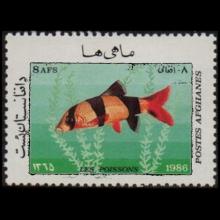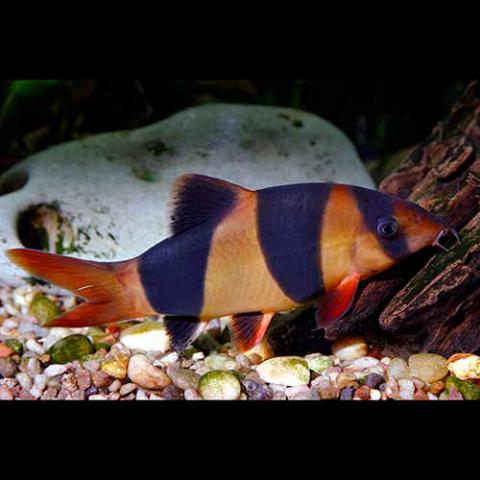NAMES
TAXONOMY
Laos
Issued:
Stamp:
Chromobotia macracanthus
Afghanistan
Issued:
Stamp:
Chromobotia macracanthus
Laos
Issued:
Stamp:
Chromobotia macracanthus
Afghanistan
Issued:
Stamp:
Chromobotia macracanthus
Laos
Issued:
Stamp:
Chromobotia macracanthus
Afghanistan
Issued:
Stamp:
Chromobotia macracanthus
excerpts from The Loach Almanac
Substrate
Loaches, being in the main part, bottomdwellers will appreciate a soft, sandy (or small pebbles) substrate that they can dig around in to their hearts content. Silver sand (playpit sand), freshwater aquatic sand, pea gravel (up to 3mm) would be ideal – avoid beach sand, coral sand, anything with sharp edges, or anything likely to affect the water chemistry. If you really feel the need to use multicolored gravel, go ahead, but bear in mind that if someone was to come into your house and paint the walls purple with fluorescent orange stripes and lime green spots, you probably wouldn’t be too happy about it. I'm not saying "Don't do it", but I prefer to see fish in a natural environment. If Nature had intended river beds to be neon blue and candy pink, then they'd be that color already!
The fish will enjoy digging and rooting around in the substrate for any tasty morsel that may have dropped there. Some species of loach (particularly horseface loaches and dojo/weather loaches) will actively cover themselves until only their eyes poke out.
Wood and Rockwork
Loaches will almost always require places to go and hide if startled – therefore provide plenty of nooks and crannies, twisted piles of bogwood, caves, etc. It may sound unusual, but the higher the number of boltholes your loaches have, the more likely you are to see them. As always, make sure that the items you’ve chosen for your aquarium are suitable for use, and won’t affect the water chemistry. Precautions should be taken to ensure that any pile of wood or rockwork cannot collapse, crushing anything that may have been beneath, or worse still, cracking the glass and causing a tank to burst. Large rock-work structures should either be avoided, or glued in place with silicone to prevent rockfalls.
Any hole is irresistible to a loach, and will often jam themselves into it, sometimes in large numbers. Some Botia have been known to take it in turns to peep out from their hidey-hole and watch the rest of the world swim by. A fish that you may think is stuck in a hole probably isn't – it will come out in its own time and only when it’s ready.
Feeding
Probably the first thing you’ll notice about your loaches is that they are constantly hungry, and no amount of food is ever going to stop them wanting more. It is the prime objective of loach-kind to continually eat ... and eat .... and eat. Fishes in general have no idea when they are full, so what their bodies don’t use, they excrete back into the water. For this reason, it is best to feed a little and often, certainly in the case of smaller fish. A small amount of food in the morning, early evening, and late at night (just before lights out for all the nocturnal feeders) will be enough to keep your fishes' tummies full, but not bloated. This is the most efficient way of feeding, as not only does it maximize the amount of food that is actually used by the fish for growth, etc, but it also saves money. As an added benefit, it reduces the amount of waste that is generated, so the filtration works better and won’t need maintaining so often.
Genus species (Animalia): Chromobotia macracanthus
The clown loach (Chromobotia macracanthus), or tiger botia, is a tropical freshwater fish belonging to the botiid loach family. It is the sole member of the genus Chromobotia. It originates in inland waters in Indonesia on the islands of Sumatra and Borneo. It is a popular fish in the freshwater aquarium trade and is sold worldwide.
Description and Behavior
Information about the maximum size of the clown loach varies, with some estimates ranging up to 20–30 cm (7.9–11.8 in), and with typical adult sizes ranging from 15–20 cm (5.9–7.9 in). The fish's body is long and laterally compressed, with an arched dorsal surface and a flat ventral surface. Its head is relatively large and its mouth faces downward with thick, fleshy lips, and four pairs of barbels. The barbels on the lower jaw are small and difficult to see. Clown loaches can make clicking sounds when they are happy, being territorial (used as a type of weapon/warning) or mating. This sound is produced by the grinding of their pharyngeal teeth.
The body is whitish-orange to reddish-orange, with three thick, black, triangular, vertical bands. The anterior band runs from the top of the head and through the eye, the medial band lies between the head and the dorsal fin, and wraps around to the ventral surface, and the posterior band covers almost all of the caudal peduncle and extends to the anal fin. There is some regional color variation within the species; the pelvic fins on fish from Borneo are reddish-orange and black, while the pelvic fins on fish from Sumatra are entirely reddish-orange.
The fish is sexually dimorphic, with females being slightly plumper than males. In addition, the tips of the tail on the male curve inwards slightly, whereas the females have straight tips.
The fish has a movable spine that lies in a groove below the eye, which may be extended as a defense mechanism. The spine may cause a painful wound, but is not venomous. It also may be used as a predation tool as it is set close to the mouth.
Distribution and habitat
Clown loaches are native to the islands of Sumatra and Borneo in Indonesia. Clear stream environments provide the optimal habitat for clown loaches, but biannual monsoon flooding forces the fish to move into flooded flood plains, or murky or blackwater rivers or lakes, for 7–8 months of the year, and clown loaches are commonly found in the flood plains of hilly areas. Breeding adults migrate to smaller waterways to spawn annually.
In its native habitat, the fish is found in water with a temperature range of 25 to 30 °C (77 to 86 °F), a pH between 5.0 and 8.0, and water hardness between 5 and 12 dH.
Reference: Wikipedia
Photo: photo: Vlad Butsky



